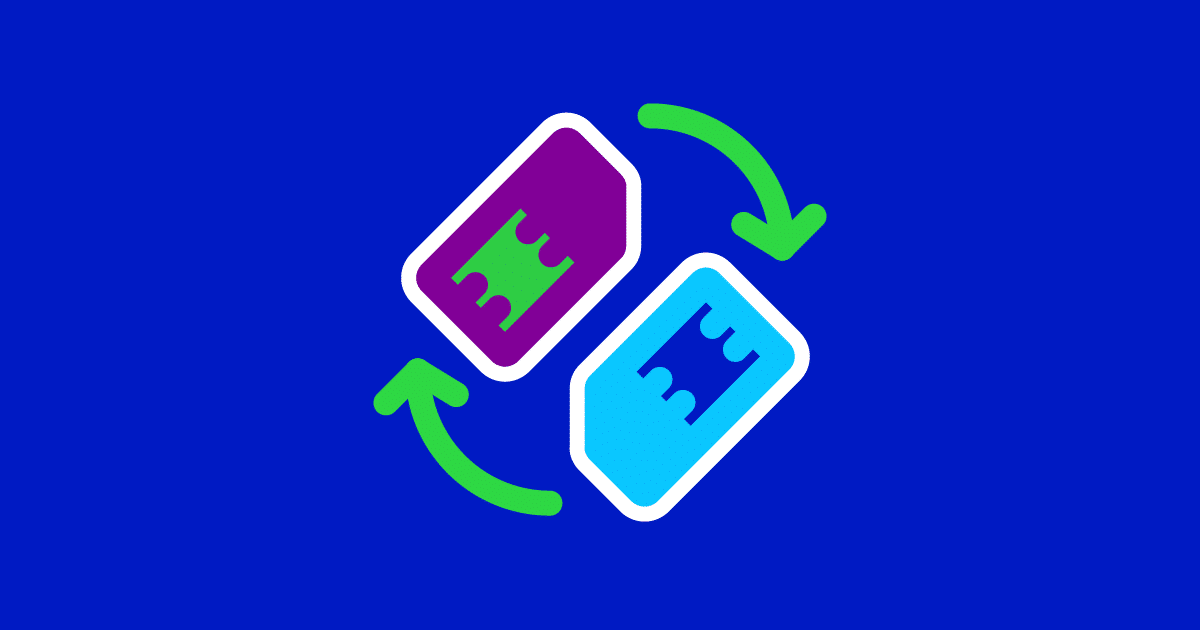
In today’s digital era, the prevalence of cyber threats is undeniable. One such threat is a SIM swap attack. Also known as SIM splitting, SIM jacking, or SIM hijacking, a SIM swap attack poses significant risks. But what exactly is a SIM swap attack, are you vulnerable to it, and what measures can you take to mitigate this threat?
In this article, we will explore various aspects of a SIM swap attack, including:
Table of Contents
How SIM swap attacks work
A SIM swap attack is not a new type of cyber threat. It impacts owners of mobile phones or other devices that rely on SIM cards and the first instances of this type of attack were observed in the early 2010s.
The backbone of these attacks is a process called SIM swapping, which was originally designed for people who lose their phones to purchase a new SIM card while retaining the functionality of the old one. However, SIM swapping involves several security protocols aimed at countering fraudsters, making this cyber threat a multifaceted challenge. Let’s explore the specifics.
The main objective of a SIM swap attack is for fraudsters to gain control of your mobile number. Once they have access to your number, they can enter your financial or other accounts and do a lot of damage. Fraudsters obtain your number by contacting your mobile carrier and persuading the support staff to facilitate the swap for them.
While you might want to blame the mobile carrier’s support staff for enabling the attack, the vulnerability—and often the reason for the attacker’s success—starts with you.
Security question information
An instance of vulnerability comes from overused security questions, such as inquiries about your mother’s maiden name, the name of your first pet, or your favorite sports team. Fraudsters can often discover this information on social media channels, effectively transforming your shared data into a potential weapon.
Phishing scams
Phishing scams involve attempts to steal personal information from you. Briefly explained, phishing involves impersonating an institution you have a relationship with, causing you to drop your guard. For example, fraudsters may send you an email from an online retailer you regularly visit. These emails are designed to resemble official communications from the company.
They will often include a link and mention topics such as failed deliveries, prizes, or other enticing offers to persuade you to click through. Attackers steal your information on the other side of this link by presenting forms that mimic personal information update forms. They can then exploit any information you submit on these forms to take advantage of you.
Out-of-sight sources
Another way for attackers to access your personal information is through less conventional means, such as the dark web. In these locations, fraudsters often purchase vast amounts of data by infiltrating anonymous databases. Once they have access to this information, fraudsters can breach your accounts and execute a SIM swap attack.
The first step is always to obtain your personal information. Once an attacker has acquired your details, they can contact your mobile provider and request a SIM swap, aiming to replace your SIM card with one of their own. If they can answer sufficient security questions or provide accurate information, the carrier may not suspect fraudulent activity and grant the swap.
The risks of SIM swap fraud
Once fraudsters succeed in the SIM swap attack, you will immediately experience its effects, starting with your mobile phone service.
There can only be one active SIM card at any given time, so when an attacker succeeds in a SIM swap attack, your” copy” will cease functioning. You will notice this lack of functionality as follows:
- You will not be able to send or receive texts, make phone calls, or access the internet. You will lose phone service, indicated by a likely absence of signal bars (usually displayed as a cross through them).
- Your cell carrier may send you a confirmation message that your phone number has been activated on a new device.
However, other, far worse problems can come from a successful SIM swap attack, including:
Getting locked out of your own accounts
One of the first steps fraudsters take during a SIM swap attack is attempting to sign in to your accounts to change passwords. Since they have your phone number, they will receive any SMS messages related to two-factor authentication, making it possible to use the” I Forgot My Password” feature on many websites. Once they reset your accounts, they gain access and can carry out malicious activities.
A common scenario involves compromised social media accounts that send phishing links to all contacts in an effort to deceive additional individuals.
Access to sensitive accounts
Compromised SIM cards can also make it easier for fraudsters to access sensitive accounts, such as banking. Once they gain access to your bank account, they can inflict significant damage.
Platform bans
Suspicious activity on any account could result in the platform banning you from further use. This type of ban can have long-lasting effects and is often extremely difficult to appeal.
Compromises information of friends and family
When a fraudster gains access to your accounts, it is safe to assume they will have access to some details of friends and family. Access to your email address alone means a whole new list of possible targets.
Most modern platforms today use more security features than SMS two-factor authentication to make it harder for fraudsters to access your account. Additional security features include biometrics, two-factor authentication apps, or email links to finalize changes to account details.
The consequences of SIM swap fraud
SIM swap attacks are lengthy and include invasion of privacy, theft, illegal acquisition of information, and even psychological harm to victims.
It is reassuring to know that perpetrators will not get off easily when caught. SIM swap fraud falls under hacking, as it involves illegally obtaining information for fraudulent purposes. Individuals caught hacking others’ accounts can face a range of punishments, from hefty fines to lengthy prison sentences, depending on the severity of the hack.
How to prevent SIM swap attacks
There are many ways to reduce your chances of falling victim to SIM swap attacks. The main thing to remember when it comes to hacks and other cyber threats is that the point of access often begins with you. With that in mind, let’s explore how to protect against SIM swap attacks.
Pay attention to your online behavior
There are numerous ways you can compromise yourself online. Whether you are posting sensitive information publicly, clicking on any links you come across, or visiting unknown, potentially unethical websites, you may be exposing yourself to a potential attack.
To enhance online security, the best approach is to cultivate better online behavior habits. Here are a few rules to keep in mind:
- Never click on links from unfamiliar emails.
- Avoid visiting dubious websites. Modern browsers can help mitigate this issue, as the in-browser security function alerts you when a website you are about to visit is deemed unsafe.
Passwords
Several approaches are available to enhance password security. One method involves ensuring you use complex passwords. For instance, the password “1234” is significantly easier to crack than a password containing numbers, letters, special symbols, and multiple characters.
Another strategy is to minimize password reuse. While this habit may be harder to adopt, it greatly enhances the security of your online presence. If the account is compromised by hackers, they won’t immediately gain access to all your accounts.
Use authentication apps
Authentication apps that employ two-factor authentication without relying on your phone number provide robust security. These apps require fraudsters to physically steal your phone in order to obtain your authentication codes.
Use all online security alerts
Regardless of how spammy these alerts might seem, keeping them on is always better. Opt to receive both a text and email when you log in to your bank account for enhanced security.
Utilize call-backs where possible
Some platforms offer call-back security features to thwart fraudsters’ attempts to successfully hack into your accounts. If someone calls them and requests access, they will call back the number of the owner to make sure they aren’t speaking to an impersonator.
Keep your customers safer with Telesign
Numerous avenues exist through which individuals can compromise their online security. Unfortunately, online fraud is an ever-present reality, and the best approach is to strengthen your security protocols. If your business is considering the implementation of multi-factor authentication within its software, Telesign offers a comprehensive suite of secure tools for this purpose. We can offer various communication and anti-fraud solutions to safeguard against identity theft.
Talk to our experts about how to integrate Telesign into your business pipeline to create a safer online environment for your customers.


